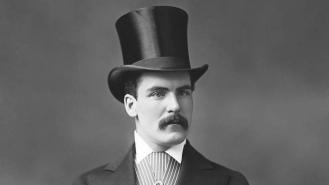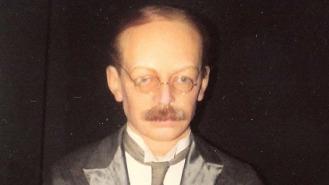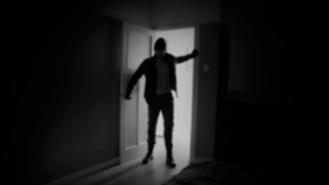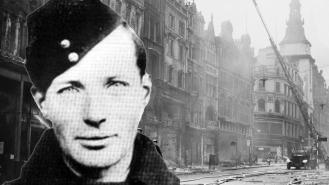
Dolly Oesterrich and the 'Lover in the Attic' murder
German-born Walburga ‘Dolly’ Oesterreich found infamy in California during the 1920s after the murder of her industrialist millionaire husband at their LA home. The case became a press sensation after it was revealed that Dolly had secretly kept a young lover in the attic of the house she shared with her husband.
Almost 100 years on, this tale of lust and love between an older married woman and a teenage youth is one of the most bizarre crimes of passion complicated by numerous affairs and an unconvincing fake robbery.
Dolly the mediator
Dolly was born to German parents in 1880 who had emigrated to the US and settled with fellow German citizens in Milwaukee. At the age of 12, the cheerful and confident girl began work at the area’s textile mill owned by Fred William Oesterreich, a workaholic industrialist who made his wealth through the production of aprons and kitchen appliances.
Some years later, the charismatic Dolly caught the eye of Oesterreich and married him when she was just 17. She settled into an uneasy relationship where material comfort barely compensated for the ill-suited union between two incompatible people. Possibly due to the boredom of her domestic life, the outgoing Dolly enjoyed being popular at her husband’s factory and became a resolver of workforce disputes, often acting as an intermediary between workers and her taskmaster husband.
Lonely heart
Dolly’s affairs began after the death of her only child, a boy who died tragically when he was 10 years old in 1910. Instead of finding solace in each other, Dolly and her husband retreated into themselves. They grew distant as he drank more and started to become abusive. Dolly kept out his way as much as she could, and Fred threw himself into work and building his empire.
Outwardly, Dolly was a social creature who craved company and the kind of love that was missing at home. At 33, her frequent visits to the factory saw her taking on a self-appointed role as a mother figure to some of the young male employees at Fred’s factory.
One youth in particular was 17-year-old orphan Otto Sanhuber. The shy sewing machine repairman was regarded as a skilled handyman at the factory and Dolly invited him to her home to fix her sewing machine. What Otto didn’t expect was Dolly opening the door in the afternoon dressed in her bedroom robe.
There was little subtlety in the way Dolly made a play for the inexperienced Otto. They made love that day and began a passionate affair where assignations took place at home during the day while Fred was at work. When Fred discovered that Otto was spending too much time with his wife, he fired him. Realising that secret meetings at local hotels weren’t an option for the couple, Dolly suggested a bizarre plan to solve their problem. She asked Otto to move into the house and live in the attic.
Lover in the attic
The teenage Otto Sanhuber was a quiet, diffident character and a loner with ambitions to be a writer. He saw Dolly as both a lover and a mother figure who comfortably set him up in the attic where he could enjoy his passion for writing and reading.
Otto ventured out into the house once Fred was at work and enjoyed the freedom of a well-stocked home. He even began to carry out domestic chores such as cleaning and washing the clothes.
Inexplicable noises
On the occasions when Fred thought he heard strange sounds coming from the house, Dolly always distracted him by offering him a drink or reminding him he was working too hard. When Fred found one of his cigars missing, or a liquor bottle slightly more empty, Dolly convinced him that he was either hearing things or not remembering where he’d put items.
California and WWI
Otto lived in the Oesterreich's attic from 1914 to 1918. As Fred's wealth grew, the couple settled into bigger homes in nicer neighbourhoods and Otto moved with them every time. In total, he lived in four different attics over the years.
In 1918, Fred decided to open a second factory in California where business was booming. Otto was now 22 years old and planned to join the army as America had entered the war. But Dolly was determined to keep him with her and told her husband she would only move to California if the house they purchased had an attic. Attics were fairly uncommon in West Coast homes, but Fred was able to locate one near Melrose Place. Dolly sent Otto on ahead to move into the attic and await her arrival. When Fred questioned the reason why Dolly kept a padlock on the attic door, she explained it was to keep her furs safe.
Murder and fake robbery
The relationship between Dolly and Fred became more volatile due to his drinking and frustrations with life. Otto heard them argue and became concerned for his lover’s safety. He was deeply in love with Dolly, wanted to protect her and even begged her to divorce Fred. Dolly maintained she had no money of her own and that Otto had to accept their ongoing clandestine affair under the same roof as her husband.
But on the evening of 22nd August 1922, Dolly and Fred began arguing violently, exacerbated by his drunken state. The yelling alerted Otto who heard Dolly cry out followed by a loud bump. Afraid that she was being attacked, Otto grabbed two 25-calibre pistols and ran out of the attic. Finding Dolly prostrate on the floor, Otto rushed towards a bewildered Fred who briefly recognised him as the young handyman he had fired years before. He lunged at Otto as one of the guns fired into the ceiling. As the men struggled Otto fired the second gun. Two bullets went into Fred’s chest and one in his head.
With Fred dead, Dolly came up with a plan to explain the shooting and they staged an attempted burglary. She took the diamond-studded watch off her husband’s wrist and gave it to Otto to hide. She entered her bedroom closet which Otto locked from the outside and then tossed the key into the living room. Once Otto had returned to the attic, Dolly screamed for help and neighbours alerted the police.
Police suspicions
When the police arrived at the Oesterreich house they found Fred dead on the floor as the apparent victim of an armed burglary. Dolly, locked in her bedroom, called out for her husband. Her story for the police was that, as she changed for bed, her closet door slammed and locked before she heard the sound of men yelling and gunshots.
When the police questioned neighbours, no one had seen or heard anything unusual that night. Despite Dolly having been locked in her bedroom from the outside, the police became suspicious of her when they discovered Fred’s cash-filled wallet was still in his pocket. Dolly also tried to paint a picture of a loving marriage, but neighbours informed officers that they actually had frequent, violent arguments.
It became clear that the couple had an acrimonious relationship, but one question niggled the police – how did Dolly manage to lock herself in the closet? Because of this glaring anomaly, a case couldn’t be made against Dolly and her husband’s murder remained a mystery.
Another attic and more affairs
Dolly and Otto moved out of the house and into a smaller home on North Beechwood Drive where, once again, the house had an attic. The couple continued their clandestine relationship hidden from public gaze. As Otto remained in the attic, Dolly began another relationship, this time with her attorney, Herman Shapiro, who was tasked with settling her dead husband’s estate.
Otto was aware that she was sleeping with another man but felt he had no control over what was taking place. Dolly showed little loyalty to Otto as she continued to have sexual relationships with other men, including a film producer called Roy Klumb. Her carefree attitude eventually drew the attention of the police once more, who had remained suspicious of her from the start of investigations a year earlier.
Missing watch
When a police inspector visited Herman Shapiro’s office, he noticed a diamond-studded watch on the attorney's desk, exactly like the one that was stolen on the night of her husband’s murder. Herman told the police that it was a gift from Dolly and admitted he was having a relationship with her.
When Dolly was questioned about the watch, she said that she had found it under a window seat cushion and claimed it must have slipped there during the robbery. But a shadow of suspicion was now looming over her, a widow with a substantial inheritance.
Revenge of spurned lovers
Herman didn’t know about Dolly’s lover in the attic, nor did he know about her third lover, Roy Klumb. Dolly had also roped Roy into disposing of one of the pistols, telling him that as it looked similar to the one that killed her husband it would be awkward for her. She persuaded him to dispose of it. Under her spell, like Otto and Herman, Roy agreed and ditched the gun in a tar pit in Los Angeles County. But when Dolly dumped Roy, the embittered film producer spilt the beans to the police investigators.
Fred Oesterreich had been killed with a 22-calibre pistol which was an uncommon weapon to commit a violent robbery with. The police knew the gun was the key clue to the killer. Officers took on the painstaking task of searching the tar pit. Eventually, it was discovered and on 12th July 1923, Dolly was arrested and charged with murder. On reading about the arrest in the paper, Dolly’s neighbour walked into the police station with the second gun. He confessed how Dolly had explained to him that she needed to dispose of the weapon out of fear of being wrongly connected with her husband’s murder. The police believed that Dolly would confess but instead, she innocently protested that the guns had been around the house for years. Despite her attempts to appear as a victim of circumstance, she was booked into jail without bail.
The vagabond brother
Herman Shapiro still visited his client in jail, where he found himself asked to carry out an odd request. Worried about Otto’s health, Dolly asked Shapiro to pick up groceries and take them to her house where he was to enter her bedroom closet and tap on the ceiling. Dolly explained that her ‘vagabond brother’, who suffered from anxiety, was staying in the attic.
Herman carried out the task and on meeting a stir-crazy Otto, listened to him spill out his entire life with Dolly and the truth of his relationship. Instead of becoming angry with Dolly for her treachery, Herman decided to help Otto get out of town so he could have Dolly to himself.
Otto moved to San Francisco before migrating to Canada where he married and changed his name to Walter Klein. It was quite some time before the police were able to catch up with him.
Herman comes clean
Although the police had heard evidence from Dolly’s former lover and a neighbour about disposing the pistols used in the murder, the weapons proved to be of little help due to damage and corrosion. The mystery of how Dolly may have shot her husband while locked in her closet was still unsolved.
Dolly was released on a $50,000 bond granted for her ill health and the murder charge against her was dismissed due to lack of evidence. She and Herman Shapiro resumed their relationship and started living together in her married home.
Trial of Dolly and the ghost in the attic
By 1930, Dolly and Herman had been a couple for seven years before she broke up with him. Either due to a sense of betrayal or the strain of a guilty conscience, Herman finally decided to tell the police everything he knew about Dolly and Otto.
Armed with this new evidence, the investigators sought out Otto, who was once again living in Los Angeles. He was arrested for the murder of Frederick Oesterreich while the police re-arrested Dolly and charged her with conspiracy. The story became a media sensation across the country. Otto, now aged 36, was dubbed ‘the ghost in the garret’, ‘attic lover’ and ‘the Batman’.
Facing the death penalty
Otto now faced the possibility of being hanged for the crime in 1922 and Dolly, at 50, was facing a long prison sentence. Fortunately for the infamous couple, the prosecutor couldn’t make a case for Frederick Oesterreich’s murder having been premeditated and the charge against Otto was reduced to manslaughter. As the statute for manslaughter had passed by one year, he escaped conviction.
On his release, Otto left Los Angeles and Dolly now faced a trial for conspiracy. Able to afford an expensive ‘celebrity’ attorney, she was well coached and advised to place all the blame on Otto as he had already been released and couldn’t be tried again. The narrative used by the defence in court was that Otto was jealous and had killed Dolly’s husband who was too drunk to defend himself. The jury, ignoring the judge’s recommendation for a guilty verdict, unexpectedly leaned towards acquittal and Dolly was set free.
Dolly lived quietly for the remainder of her life and had a 30-year relationship with her business manager. She married him just two weeks before her death in 1961 at the age of 80, leaving him a multimillion-dollar estate. There was no mention of Otto in the will.












